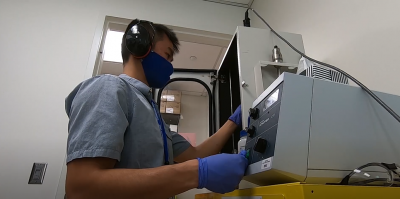Andrew Nguyen

The pathology of human neurodegenerative diseases is associated with protein aggregation. This ranges from polyglutamine (polyQ) aggregation in Huntington’s Disease to beta-amyloid and tau aggregation in Alzheimer’s. Originally, the project aimed to investigate how SRCP1, a protein previously discovered by the Scaglione Lab to reduce polyQ aggregation in human cells, would affect tau protein aggregation and disease progression in a tau mouse model of Alzheimer’s Disease. The mice would have been injected at age P0 with an intracranial injection of either SRCP1 treatment or two control injections consisting of either a placebo treatment (RFP) or a sham injection. After 6 months, the brains of these mice would have been collected for brain slide immunohistochemistry and brain lysate Western immunoblotting. Tau aggregation would be compared between SRCP1 treated mice and control treated mice.
However, it was found in other experiments that cells treated with the positive control RFP adeno-associated virus (AAV) vector did not successfully express RFP as would have been expected. Previous experiments in the lab confirmed that different AAV vectors used previously successfully infected cells and mouse models, leading us to believe that there was an issue with this particular vector. Because it would have taken weeks to troubleshoot and to construct and find a new virus, I took on a new project with my PI’s guidance.
Stress granules, consisting of RNA and protein, form in cells in response to cellular stressors and play an important role in the pathology of several neurodegenerative diseases, including amyotrophic lateral sclerosis and Alzheimer’s Disease. The removal of stress granules from cells, however, is not well understood. Recent publications revealed that G3BP1 plays an important role in stress granule disassembly, a pathway which may have therapeutic potential. G3BP1 interacts with the ubiquitin-proteasome pathway, and previously, Dr. Scaglione had found mutations in CHIP, an E3 ligase, to underlie another neurodegenerative disease: spinocerebellar ataxia autosomal recessive type 16 (SCAR16). CHIP facilitates the ubiquitination of various proteins. To determine whether G3BP1 might affect CHIP protein stability or vice versa, interactions between G3BP1 and various CHIP mutants were therefore investigated.
U2OS cells were transfected to express G3BP1 and one of the following: pcDNA vector only, wild-type CHIP, CHIP A52G, or CHIP P228S. These mutants were selected for their positions in two of the protein’s domains, the U-box domain and the TPR domain, respectively. The U-box domain facilitates its E3 ubiquitin ligase activity while the TPR domain facilitates interactions with molecular chaperones like Hsp70 (70 kilodalton heat shock protein). Western blotting and fluorescent imaging techniques were used to compare cells from each group. Technical triplicates and four biological repeats of these experiments were conducted. Fluorescent images did not appear to show a significant difference in localization or GFP-tagged G3BP1 presence in cytoplasmic stress granules. There also did not appear to be a statistically significant difference between the stabilities of G3BP1 or CHIP protein in any one of the conditions described above.
This project did not yield any statistically significant results regarding G3BP1 and CHIP, but future projects may address other characteristics of G3BP1 that are still unknown. The mechanisms by which G3BP1 aids in stress granule disassembly are not yet fully understood. It has been found that Hsp70 is also involved in stress granule disassembly, so it may be interesting to find if there are key interactions between Hsp70 and G3BP1 in this function.